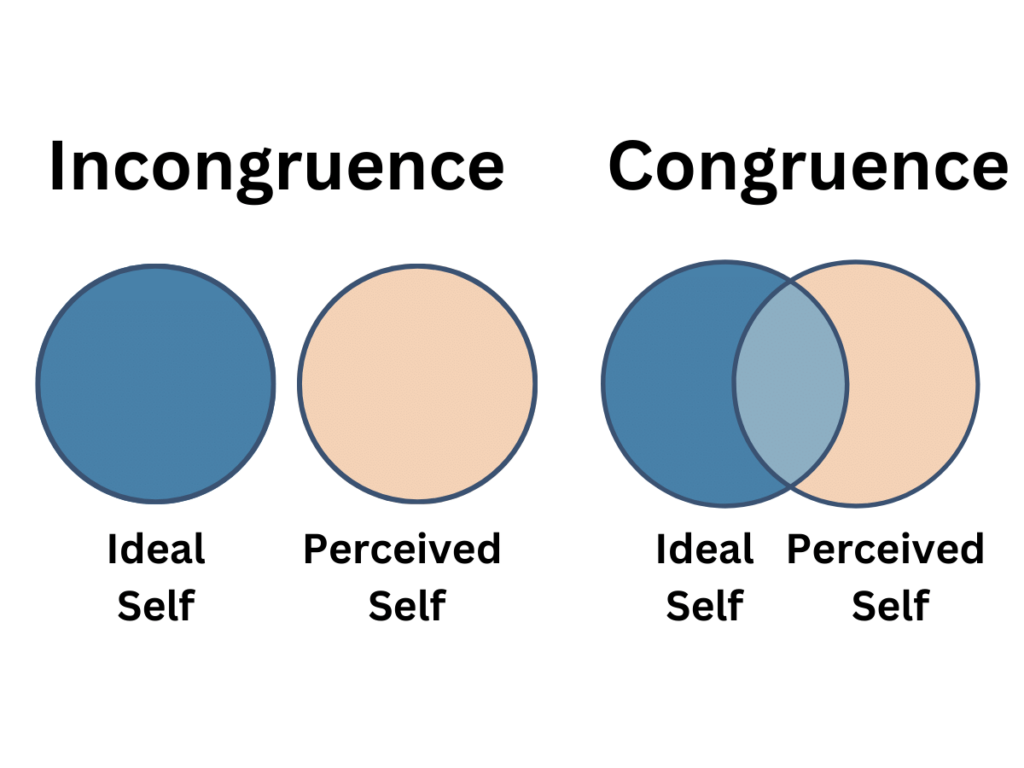Incongruence in Psychology: Definition and Examples
Incongruence, a psychological mismatch between your self-perception and ideal self, can lead to emotional distress and hinder personal growth. Carl Rogers’ humanistic theory highlights how aligning these aspects is crucial for well-being. Key Takeaways What Is Incongruence? Incongruence, as defined by psychologist Carl Rogers, occurs when there’s a disparity between your perceived self and your…

Incongruence, a psychological mismatch between your self-perception and ideal self, can lead to emotional distress and hinder personal growth. Carl Rogers’ humanistic theory highlights how aligning these aspects is crucial for well-being.
Key Takeaways
- Incongruence occurs when there’s a mismatch between one’s perceived self and ideal self.
- Carl Rogers’ theory suggests that incongruence leads to emotional distress and hinders personal growth.
- Overcoming incongruence involves self-reflection, mindfulness, realistic goal-setting, and supportive relationships.
What Is Incongruence?
Incongruence, as defined by psychologist Carl Rogers, occurs when there’s a disparity between your perceived self and your ideal self. This misalignment can lead to emotional discomfort and motivate efforts to resolve the conflict through self-improvement and self-actualization.
Incongruence involves a discrepancy or inconsistency between a person’s thoughts, feelings, behaviors, or self-concept. According to the humanist psychologist Carl Rogers, incongruence happens when a person’s ideas about their ideal self don’t align with their real-world experiences.
Simply put, incongruence means a person’s perceived self does not match their ideal self.
When people experience incongruence, they may feel anxious, uncomfortable, and motivated to take steps to better align their current self with the person’s ideal self.
Rogers believed that people seek to resolve this conflict through the self-actualization process.
Rogers’ Theory of Incongruence
Incongruence is associated with the humanistic theories of psychologist Carl Rogers. Rogers introduced an approach to psychotherapy known as person-centered therapy, also known as client-centered therapy.
The goal of this type of therapy is to help people achieve their goals and align their self-concept with their vision of who they want to be.
Self-concept plays an important part in Rogers’ theory of personality. Rogers described self-concept as a set of organized beliefs about the self. This self-concept is made up not just of how we see ourselves or our self-image; it also includes how we feel about ourselves (or our self-esteem) and the person we wish we could be (or our ideal self).
The ideal self is the person you aspire to be. It involves the goals and dreams you have for yourself. When the ideal self is closely aligned with how people perceive themselves, they are congruent.

Rogers believed that mental distress and dysfunction arise when a person’s self-concept is out of sync with their emotions, behaviors, or experiences. When this incongruence happens, the way that person experiences themselves and their life doesn’t match how they imagine their life should be or the person they wish they were.
For example, if a person imagines themselves as honest but regularly cheats on their taxes, they may experience incongruence.
What Causes Incongruence?
There are a number of factors that can contribute to a state of incongruence.
- Unrealistic expectations: If a person’s ideal self is unrealistic, they are more likely to experience incongruence because they will never match up to the overly high standards in their head.
- Societal expectations: For example, societal expectations centered on traditional gender roles can create incongruence if a person’s authentic self does not fit within these prescribed roles.
- Cognitive distortions: Distorted self-perceptions can create a conflict between a person’s perceived self and their ideal self.
Conditional Positive Regard
Conditional positive regard occurs when people only get love and acceptance when they can meet certain conditions. In Rogers’ theory, if a person experiences love only when conforming to expectations, they may develop an incongruent self-concept. Because they have to suppress aspects of themselves to gain approval, it leads to inner conflict.
Rogers believed that unconditional positive regard was critical for achieving congruence. Unconditional positive regard involves accepting a person for who they are without conditions. It is given without judgment, criticism, or expectation and isn’t withdrawn if a person makes mistakes.
Effects of Incongruence
Incongruence can affect well-being in many ways. When people internalize conditions on their self-worth, it can affect how they value themselves and distort how they see themselves.
Authenticity is a key part of becoming a self-actualized person. When people are experiencing incongruence, it often means they are hiding aspects of themselves to fit in with outside expectations.
Because incongruence hurts authenticity, it also stifles personal growth. This hampers the actualizing tendency and makes it more difficult for them to become what Rogers described as fully functioning people.
Incongruence also leads to emotional distress and cognitive dissonance. It feels uncomfortable and upsetting when how we see ourselves doesn’t match up with how we actually act in real-life.
How to Overcome Incongruence
One of the goals of therapy is to help people overcome incongruence and better align their perceived self with their ideal self. Rogers believed this involved building a more authentic self-concept. To do this, you can:
Engage in Self-Reflection
Engaging in self-reflection can build stronger self-awareness and help bridge the gap between the perceived self and ideal self, which can reduce feelings of incongruence.
- Spend time reflecting on your values and beliefs
- Consider how you see yourself
- Reflect on your experiences
- Look for discrepancies between how you see yourself and how you actually behave
Practice Self-Compassion
Try not to be too hard on yourself if you’re struggling with feelings of incongruence. Instead, remember that nobody is perfect and everyone makes mistakes. If there are things you are not happy with, you can take steps to change them and learn from the past.
Build a Growth Mindset
A growth mindset involves recognizing that you are capable of learning, growing, and changing. It’s important to understand that personal development isn’t a one-and-done thing; it’s an ongoing process. There are always new things to learn and new challenges to embrace. By always being open to new learning opportunities and experiences, you can keep working toward becoming a self-actualized person.
Cultivate Mindfulness to Increase Self-Awareness
Mindfulness is a practice that can help keep you focused on the here and now. Rather than ruminating on the past and worrying about the future (which can contribute to incongruence), mindfulness can help you build a better awareness of how you feel in the moment. This can help you better understand your emotions, thoughts, and actions, free of judgment and criticism.
Set Realistic Goals
To better align your perceived self with your ideal self, it is important to set realistic, achievable goals. Because you’ve spent time thinking about your ideals and values, you’ll have a better idea of what you hope to achieve in the short- and long-term. Focus on setting short-term goals that help support the long-term goals you have for who you want to be.
Seek Supportive Relationships
Authentic, supportive relationships are incredibly important for fostering greater congruence. Surround yourself with people who offer unconditional positive regard. These are the friends, loved ones, and others in your life who accept you for who you are and are willing to let you be your authentic self, free of judgment, criticism, and shame.
Consider Therapy to Overcome Incongruence
Therapy can be an essential tool for overcoming incongruence. Person-centered, humanistic approaches can help provide a supportive, non-directive, non-judgmental environment where you can explore your authentic self.
By providing unconditional positive regard and empathy, therapists give people a safe space to explore their thoughts, feelings, and behaviors. A therapist can also help people identify external conditions of worth contributing to incongruence and develop coping mechanisms to build a more authentic sense of self-worth.



